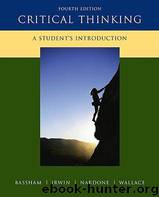Critical Thinking-A Student's Introduction by Gregory Bassham

Author:Gregory Bassham
Language: eng
Format: mobi
Tags: Philosophy
ISBN: 9780073407432
Publisher: McGraw-Hill Humanities/Social Sciences/Languages
Published: 2002-01-02T00:00:00+00:00
Inductive Generalizations
295
CALVIN AND HOBBES © Watterson. Reprinted with permission of Universal Press Syndicate. All rights reserved.
he might have a tendency to approach only people who look “friendly.” This
may mean that he is more inclined to approach a well-dressed businesswoman
and much less inclined to approach a disheveled man. This may introduce a
gender bias and a socioeconomic bias into the sample population, automati-
cally eliminating a signifi cant portion of the population, namely, lower-class
males. Perhaps the problem could be solved by randomly selecting the people
on the street to be approached. For example, the pollster could be given in-
structions to approach every tenth person who walks down the block. This
would certainly be a better strategy than simply allowing the pollster to ap-
proach the people he chooses on the basis of his own whims. Still, there can
be problems. For example, if you asked every tenth high school student who
walked down the street in Scarsdale, New York, if he or she was planning to
go to college, you would get some uncharacteristic results. Perhaps 90 per-
cent of the high school students in this wealthy suburb would indicate that
they were planning to go to college, whereas the national average is closer to
60 percent.
Still another factor that may affect the reliability of polls is dishonesty. We all like to give the “right answer” to a question, even when the question does
not have a right answer but is simply a matter of opinion or an attempt to collect
information. The result is that some people lie in response to anonymous polls.
For example, in response to the question, “Do you consider yourself racially
prejudiced?” we can expect more people to respond no than is actually the
case. People think that the “right answer” is no, so some will answer no even if
they do indeed consider themselves racially prejudiced. Polling agencies often
take advantage of this tendency of people to try to give the right answer by
bas07437_ch11_285-329.indd 295
11/24/09 8:38:37 AM
296
CHAPTER 11 Inductive Reasoning
asking slanted questions. That is to say, polling agencies may not be interested
in gathering objective data and so ask questions that clearly point toward one
response as the right answer. For example, depending on the answer that a
polling agency wants respondents to consider the right answer, they might
ask two very different questions. On the subject of whether the United States
should decrease the size of its nuclear arsenal, a polling agency might ask, “Are
you in favor of peaceful multilateral nuclear disarmament?” Or, alternatively,
“Are you against the weakening of the ability of the United States of America
to offer a suffi cient nuclear deterrent against foreign attack?” There is not much
need to wonder what the right answer is in each case. Polling is big business, and
those who hire polling agencies often have a vested interest in getting results
that confi rm their own position on an issue.
Another potential pitfall of objective polling is the person who is doing
the poll. Even without intending to, he or she may provide a clue as to what
the right answer is, or respondents may answer differently depending on the
pollster. A white male is much
Download
This site does not store any files on its server. We only index and link to content provided by other sites. Please contact the content providers to delete copyright contents if any and email us, we'll remove relevant links or contents immediately.
The remains of the day by Kazuo Ishiguro(8790)
Tools of Titans by Timothy Ferriss(8186)
Giovanni's Room by James Baldwin(7164)
The Black Swan by Nassim Nicholas Taleb(6989)
Inner Engineering: A Yogi's Guide to Joy by Sadhguru(6705)
The Way of Zen by Alan W. Watts(6480)
Asking the Right Questions: A Guide to Critical Thinking by M. Neil Browne & Stuart M. Keeley(5599)
The Power of Now: A Guide to Spiritual Enlightenment by Eckhart Tolle(5584)
The Six Wives Of Henry VIII (WOMEN IN HISTORY) by Fraser Antonia(5380)
Astrophysics for People in a Hurry by Neil DeGrasse Tyson(5120)
Housekeeping by Marilynne Robinson(4306)
12 Rules for Life by Jordan B. Peterson(4237)
Double Down (Diary of a Wimpy Kid Book 11) by Jeff Kinney(4179)
The Ethical Slut by Janet W. Hardy(4163)
Skin in the Game by Nassim Nicholas Taleb(4144)
Ikigai by Héctor García & Francesc Miralles(4102)
The Art of Happiness by The Dalai Lama(4051)
Skin in the Game: Hidden Asymmetries in Daily Life by Nassim Nicholas Taleb(3907)
Walking by Henry David Thoreau(3878)
